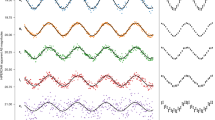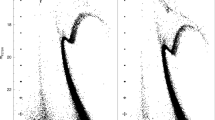Abstract
White dwarfs represent the endpoint of stellar evolution for stars with initial masses between approximately 0.07 and 8–10 , where
, where  is the mass of the Sun (more massive stars end their life as either black holes or neutron stars). The theory of stellar evolution predicts that the majority of white dwarfs have a core made of carbon and oxygen, which itself is surrounded by a helium layer and, for ∼80 per cent of known white dwarfs, by an additional hydrogen layer1,2,3. All white dwarfs therefore have been traditionally found to belong to one of two categories: those with a hydrogen-rich atmosphere (the DA spectral type) and those with a helium-rich atmosphere (the non-DAs). Here we report the discovery of several white dwarfs with atmospheres primarily composed of carbon, with little or no trace of hydrogen or helium. Our analysis shows that the atmospheric parameters found for these stars do not fit satisfactorily in any of the currently known theories of post-asymptotic giant branch evolution, although these objects might be the cooler counterpart of the unique and extensively studied PG 1159 star H1504+65 (refs 4–7). These stars, together with H1504+65, might accordingly form a new evolutionary sequence that follows the asymptotic giant branch.
is the mass of the Sun (more massive stars end their life as either black holes or neutron stars). The theory of stellar evolution predicts that the majority of white dwarfs have a core made of carbon and oxygen, which itself is surrounded by a helium layer and, for ∼80 per cent of known white dwarfs, by an additional hydrogen layer1,2,3. All white dwarfs therefore have been traditionally found to belong to one of two categories: those with a hydrogen-rich atmosphere (the DA spectral type) and those with a helium-rich atmosphere (the non-DAs). Here we report the discovery of several white dwarfs with atmospheres primarily composed of carbon, with little or no trace of hydrogen or helium. Our analysis shows that the atmospheric parameters found for these stars do not fit satisfactorily in any of the currently known theories of post-asymptotic giant branch evolution, although these objects might be the cooler counterpart of the unique and extensively studied PG 1159 star H1504+65 (refs 4–7). These stars, together with H1504+65, might accordingly form a new evolutionary sequence that follows the asymptotic giant branch.
This is a preview of subscription content, access via your institution
Access options
Subscribe to this journal
Receive 51 print issues and online access
$199.00 per year
only $3.90 per issue
Buy this article
- Purchase on Springer Link
- Instant access to full article PDF
Prices may be subject to local taxes which are calculated during checkout

Similar content being viewed by others
References
Iben, I. On the frequency of planetary nebula nuclei powered by helium burning and on the frequency of white dwarfs with hydrogen-deficient atmospheres. Astrophys. J. 277, 333–354 (1984)
Koester, D. & Schoenberner, D. Evolution of white dwarfs. Astron. Astrophys. 154, 125–134 (1986)
D’Antona, F. & Mazzitelli, I. Evolutionary times of white dwarfs—Long or short? IAU Colloq. 95, 635–637 (1987)
Nousek, J. A. et al. H 1504 + 65—an extraordinarily hot compact star devoid of hydrogen and helium. Astrophys. J. 309, 230–240 (1986)
Werner, K. NLTE analysis of the unique pre-white dwarf H 1504 + 65. Astron. Astrophys. 251, 147–160 (1991)
Werner, K. & Wolff, B. The EUV spectrum of the unique bare stellar core H1504+65. Astron. Astrophys. 347, L9–L13 (1999)
Werner, K., Rauch, T., Barstow, M. A. & Kruk, J. W. Chandra and FUSE spectroscopy of the hot bare stellar core H 1504+65. Astron. Astrophys. 421, 1169–1183 (2004)
Pelletier, C., Fontaine, G., Wesemael, F., Michaud, G. & Wegner, G. Carbon pollution in helium-rich white dwarf atmospheres. Time-dependent calculations of the dredge-up process. Astrophys. J. 307, 242–252 (1986)
Dufour, P., Bergeron, P. & Fontaine, G. Detailed spectroscopic and photometric analysis of DQ white dwarfs. Astrophys. J. 627, 404–417 (2005)
Wegner, G. & Koester, D. Atmospheric analysis of the carbon white dwarf G227–5. Astrophys. J. 288, 746–750 (1985)
Thejll, P., Shipman, H. L., MacDonald, J. & Macfarland, W. M. An atmospheric analysis of the carbon-rich white dwarf G35 – 26. Astrophys. J. 361, 197–206 (1990)
Desharnais, S., Wesemael, F., Chayer, P. & Kruk, J. W. FUSE observation of cool DB white dwarfs. ASP Conf. Ser. 372, 265–268 (2007)
Liebert, J. et al. SDSS white dwarfs with spectra showing atomic oxygen and/or carbon lines. Astron. J. 126, 2521–2528 (2003)
Beauchamp, A. Détermination des Paramètres Atmosphériques des Étoiles Naines Blanches de Type DB. PhD thesis, Montréal. (1995)
Behara, N. & Jeffery, C. S. LTE model atmosphere with new opacities. 1. Methods and general properties. Astron. Astrophys. 451, 643–650 (2006)
Eisenstein, D. J. et al. A catalog of spectroscopically confirmed white dwarfs from the Sloan Digital Sky Survey data release 4. Astrophys. J. 167 (Suppl.). 40–58 (2006)
Herwig, F., Blöcker, T., Langer, N. & Driebe, T. On the formation of hydrogen-deficient post-AGB stars. Astron. Astrophys. 349, L5–L8 (1999)
Werner, K. & Herwig, F. The elemental abundances in bare planetary nebula central stars and the shell burning in AGB stars. Publ. Astron. Soc. Pacif. 118, 183–204 (2006)
Garcia-Berro, E. & Iben, I. On the formation and evolution of super-asymptotic giant branch stars with cores processed by carbon burning. 1: SPICA to Antares. Astrophys. J. 434, 306–318 (1994)
Garcia-Berro, E., Ritossa, C. & Iben, I. On the evolution of stars that form electron-degenerate cores processed by carbon burning. III. The inward propagation of a carbon-burning flame and other properties of a 9M⊙ model star. Astrophys. J. 485, 765–784 (1997)
Ritossa, C., Garcia-Berro, E. & Iben, I. On the evolution of stars that form electron-degenerate cores processed by carbon burning. V. Shell convection sustained by helium burning, transient neon burning, dredge-out, URCA cooling, and other properties of an 11 M⊙ population I model star. Astrophys. J. 515, 381–397 (1999)
Koester, D. & Knist, S. New DQ white dwarfs in the Sloan Digital Sky Survey DR4: confirmation of two sequences. Astron. Astrophys. 454, 951–956 (2006)
Holberg, J. B. Oswalt, T. D. & Sion, E. M. A determination of the local density of white dwarf stars. Astrophys. J. 571, 512–518 (2002)
Acknowledgements
This work has been partially supported by the NSF for work on SDSS white dwarfs. This work was also supported in part by the NSERC (Canada).
Author Contributions P.D. developed the models, performed the analysis and wrote the paper. J.L. was involved in the discovery of the SDSS spectra. G.F. elaborated the evolutionary scenario discussed in the text. N.B. provided opacity data necessary to the computation of the models. All authors discussed the results and commented on the manuscript.
Author information
Authors and Affiliations
Corresponding author
Rights and permissions
About this article
Cite this article
Dufour, P., Liebert, J., Fontaine, G. et al. White dwarf stars with carbon atmospheres. Nature 450, 522–524 (2007). https://doi.org/10.1038/nature06318
Received:
Accepted:
Issue Date:
DOI: https://doi.org/10.1038/nature06318
This article is cited by
-
The spectral evolution of white dwarfs: where do we stand?
Astrophysics and Space Science (2024)
-
An ultra-massive white dwarf with a mixed hydrogen–carbon atmosphere as a likely merger remnant
Nature Astronomy (2020)
-
A measurement of the equation of state of carbon envelopes of white dwarfs
Nature (2020)
-
Femtosecond laser produced periodic plasma in a colloidal crystal probed by XFEL radiation
Scientific Reports (2020)
-
A massive white-dwarf merger product before final collapse
Nature (2019)
Comments
By submitting a comment you agree to abide by our Terms and Community Guidelines. If you find something abusive or that does not comply with our terms or guidelines please flag it as inappropriate.



